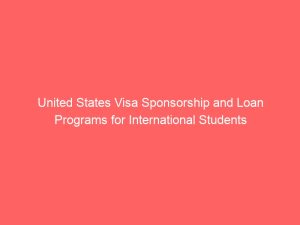The United States is one of the most sought-after destinations for people across the world seeking career advancement, higher income opportunities, and a better quality of life. One of the biggest challenges for foreign workers moving to the United States is not only securing a valid work visa but also finding financial support for essential needs like housing. Fortunately, some employers and financial institutions in the U.S. now offer programs that combine visa sponsorship with housing loan assistance. This combination can make it significantly easier for newcomers to settle in the country, focus on their jobs, and plan for long-term stability.
This guide explores how visa sponsorship works in the United States, what housing loan assistance programs are available, who qualifies, and how you can successfully take advantage of these opportunities.
Understanding Visa Sponsorship in the United States
Visa sponsorship is when a U.S. employer, organization, or institution agrees to take responsibility for a foreign worker’s legal right to live and work in the country. This involves helping them obtain the necessary work visa, paying the required fees, and ensuring compliance with U.S. immigration laws. Without sponsorship, most foreign workers cannot legally work in the country unless they have independent immigration status.
Common visa types that require sponsorship include:
- H-1B Visa: For specialty occupations like IT, engineering, or healthcare.
- H-2B Visa: For seasonal or temporary non-agricultural jobs.
- O-1 Visa: For individuals with extraordinary abilities in science, arts, education, business, or athletics.
- EB-3 Visa: For skilled workers, professionals, and unskilled workers seeking permanent residency.
When a company offers visa sponsorship, it shows they are committed to hiring foreign talent and supporting their immigration process.
Housing Loan Assistance for Immigrants in the U.S.
Housing loan assistance refers to programs that help new arrivals in the United States secure financing for housing. This could be in the form of a mortgage for purchasing a home or temporary loans for renting a property until the worker is financially stable. Some employers include housing support as part of their relocation package, especially for high-demand roles.
Housing assistance can include:
- Employer-sponsored housing loans or allowances
- Partnerships with banks offering favorable mortgage terms to sponsored workers
- Government or community-based programs supporting immigrants
- Down payment assistance for first-time homebuyers
- Rental loan programs for workers without established U.S. credit history
Combining visa sponsorship with housing loan assistance means that you get both legal permission to work in the U.S. and the financial ability to secure a place to live quickly after arrival.
How Visa Sponsorship and Housing Loan Assistance Work Together
Employers who sponsor visas often recognize that foreign employees may face difficulties securing housing due to lack of U.S. credit history, proof of income in the country, or knowledge of the local housing market. To address this, some employers partner with banks or lending institutions to provide loan guarantees or special financing packages for their sponsored employees. This makes it easier for you to rent or purchase a home upon arrival.
For example:
- A tech company hiring a software engineer from abroad on an H-1B visa might work with a local bank to offer a low-interest mortgage program.
- A hospital hiring a nurse from overseas on an EB-3 visa might provide a relocation bonus that can be used as a down payment on a house.
- A manufacturing company hiring skilled tradespeople on an H-2B visa might cover initial rental costs until the worker establishes themselves financially.
Benefits of This Combination
The advantages of securing both visa sponsorship and housing loan assistance are substantial:
- Faster settlement in the U.S., reducing the stress of relocation.
- Improved financial stability by avoiding high initial housing costs.
- Ability to buy property earlier, which can be a long-term investment.
- Access to better living conditions, improving work-life balance.
- Enhanced loyalty and job satisfaction, as the employer supports personal and professional needs.
Eligibility Requirements
The exact requirements for visa sponsorship and housing loan assistance will vary depending on the employer, visa type, and financial institution. However, common eligibility criteria include:
- Securing a job offer from a U.S. employer willing to sponsor your visa.
- Meeting the skill or education requirements for the sponsored visa type.
- Providing proof of employment contract or sponsorship letter.
- Meeting minimum income requirements for loan approval.
- Having a valid passport and relevant work experience.
- In some cases, providing a co-signer for housing loans.
Step-by-Step Guide to Applying
- Find an Employer Offering Both Benefits
Look for U.S. companies in industries such as technology, healthcare, engineering, and education, as they are more likely to offer combined sponsorship and housing benefits. - Prepare Your Documents
Have your resume, academic qualifications, professional certifications, and work experience records ready. - Secure the Job Offer
Once you have an interview and pass the selection process, request details of the visa sponsorship and housing assistance program. - Submit Visa Application
Work with your employer’s legal team to file the necessary immigration documents. - Apply for Housing Loan Assistance
Your employer or partnering financial institution will guide you through the loan application process. - Relocate and Settle
Once both visa and housing arrangements are confirmed, you can move to the U.S. and begin your new job.
Industries Offering Visa Sponsorship with Housing Loan Assistance
Certain industries are more likely to offer both visa sponsorship and housing benefits because they actively recruit foreign workers for specialized roles:
- Technology (software developers, data scientists)
- Healthcare (nurses, doctors, medical technicians)
- Education (teachers, professors)
- Engineering (civil, mechanical, electrical engineers)
- Skilled trades (welders, electricians, machinists)
Challenges to Expect
While this combination offers many benefits, there are challenges to consider:
- Housing loan approval may still be more difficult without a U.S. credit history.
- Some programs require you to remain with the employer for a set period.
- Visa processing times can be long, delaying your relocation.
- Housing markets in certain U.S. cities can be highly competitive and expensive.
Tips for Success
- Target employers known for strong relocation support packages.
- Be upfront about your housing needs during the hiring process.
- Build a relationship with your employer’s HR and relocation teams.
- Research U.S. mortgage and rental systems in advance.
- Save funds for unexpected housing-related expenses.
Future Outlook
The trend of combining visa sponsorship with housing loan assistance is expected to grow, especially as U.S. employers continue to face skills shortages in critical sectors. With more companies competing for global talent, offering financial support for housing can be a powerful recruitment tool.
Conclusion
For immigrants aiming to work in the United States, the combination of visa sponsorship and housing loan assistance offers a rare opportunity to start a new life with both legal and financial stability. By targeting employers and programs that provide these benefits, you can ease your transition into the U.S., secure comfortable housing, and focus on building your career. If you plan ahead, prepare your documentation, and apply strategically, you can take full advantage of these opportunities and create a strong foundation for your future in America.




